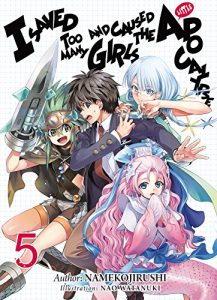By Namekojirushi and Nao Watanuki. Released in Japan as “Ore ga Heroine o Tasukesugite Sekai ga Little Mokushiroku!?” by Hobby Japan. Released in North America digitally by J-Novel Club. Translated by Adam Lensenmayer.
I was somewhat taken by surprise by the ending to this volume, as I kept reading and thinking “shouldn’t things be wrapping up soon?” It wasn’t until I got right near the end that I realized this would be Little Apocalypse’s first two-parter, something that should have been mnre obvious given this book features four heroines but only two of them are on the cover. It might be frustrating to wait till the 8th book too, as this volume actually ended up being one of the strongest in the series to date. The author has realized there’s only so far he can go with parody, and has moved on to deconstruction, which is a far richer vein. He’s also gotten better at juggling the heroines – sure, some are still missing or deliberately left out, but the balance we get here shows he’s thinking “who needs more attention?”, so Harissa gets a larger role here, as does Tsumiki. The series is beginning to mature… as much as a series like this can.
As I said, we stack up four different heroines in this book, and they are of a wide variety: an idol singer who’s getting tired of the grind; a psychic (which is a much broader term in Japan than it is here) on the run from a yakuza-like psychic gang; a (seeming) former hero sealed in the depths of an alien dungeon; and a sylpheed (wind fairy) dealing with a zombie infestation. It’s a tall order even for someone like Rekka. Fortunately, his current harem is not at war with each other (that’s supposedly in the future), and he is thus able to use them as sort of a mobile army. Thus, he and a team of girls go off to try to solve one issue, and Hibiki and another group try to work on the psychic problem. I really liked this, and enjoy that (for the most part) there’s not really much rivalry between the girls when serious events are happening. We also get lampshaded how weird everyone is when Rekka explains who he is to the idol and is surprised she DOESN’T know about magic.
The other highlight of the book is a bit of a spoiler, but I want to discuss it anyway: what happens when Rekka fails? And how do we define failure? The sylpheed rejects Rekka because her sister (who we saw in the prologue) is already dead – she died before Rekka even arrived in her world. As R points out, that doesn’t mean that the story is over, and Rekka is working on another aspect of it by trying to fix the zombie thing. But Rekka fixing the stories usually ends with everyone happy (and happily in love with Rekka), and that doesn’t seem like it’s going to work out this time around. Now yes, I am very familiar with the genre, and would not be too surprised if a magical sister-saving solution popped up in Book 8. But it’s still a good question to ask: what if Rekka fails? Can he deal with the aftermath of NOT saving someone’s story?
The book ends with everyone in trouble, and we’ve got to wait a bit till the next one. But Little Apocalypse in general has been qa quick, light, fluffy read. It’s nice to see it gain a bit of added depth.



